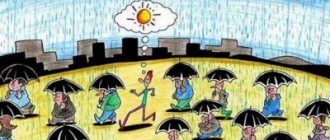Recently, the term “clip thinking” can be heard more and more often. What does this concept mean?
The word “clip” translated from English means “fragment”, “clipping”, “segment”, “excerpt”. Thus, this phenomenon represents a type of thinking in which a person perceives the world around him as a set of fragmentary, disparate, little interconnected images.
A person with clip thinking can effectively work only with short pieces of information and finds it difficult to perceive large and complex volumes. Almost all modern children and young people are susceptible to this phenomenon, to one degree or another.
Clip thinking - hypothesis
Clip thinking (from the English clip - fragment, excerpt from a film, clip, newspaper clipping) is a feature of a modern person to figuratively perceive information through a short broadcast, messages flashed in the media news, the Internet. When did the term “clip thinking” appear? The first mention as “clip culture” - the phenomenon is described in the book of the American futurist E. Toffler “The Third Wave” as an endless flickering of information segments.
Signs of clip thinking
The problem of clip thinking is becoming widespread; it becomes sad when a person is completely “lost” in the information jungle, has forgotten how to think and think independently: “Why, if you can ask Google?” A person with clipping consciousness can be identified by the following characteristics:
- poverty of facial expressions and emotions;
- lack of empathy (compassion);
- hasty judgments and conclusions;
- poor vocabulary, quoting phrases from films, aphorisms, memes from social networks;
- problems with remembering.
Pros and cons of clip thinking
It is impossible to say unequivocally that the phenomenon of clip consciousness is bad. There are always good reasons for any kind of phenomenon to occur, and the danger of clip thinking comes from focusing on the negative aspects of a phenomenon. To understand what you should be wary of and what you can take advantage of, it is important to highlight the positive and negative aspects of clip thinking:
- speed of reaction and efficiency in rapidly changing conditions, when making important decisions;
- productivity while multitasking;
- quick switching of attention;
- protecting the brain from overload with excessive information;
- intellectual growth, absorption of different types of information, desire to understand the world.
Minuses:
- analysis of information is replaced by its consumption, without “digestion”;
- reduced concentration of attention on a specific task (spasmodic attention);
- lack of deep assimilation of knowledge;
- susceptibility to other people's influence and manipulation;
- impoverishment of emotional intelligence - in the era of an avalanche of negativity (cruelty, violence) broadcast by the media, the psyche is protected, and feelings of empathy and responsibility are dulled;
- in the face of a complex task - confusion and inability to solve it.
Appearance of the term
The term “clip thinking” or “clip consciousness” originated in psychology relatively recently – in the mid-90s. It was then that various music videos began to appear en masse on domestic television, the plots of which, as a rule, do not represent a holistic, complete image, but a chain of video frames with little connection to each other in meaning. Very often the meaning of the song being played turns out to be logically unrelated to the theme of the video presented to the viewer.
In subsequent years, more and more films, cartoons and television shows are built precisely on this principle: the plot in them is divided into short blocks of information, often replacing each other and not having any special logical connection. Another striking example is television advertising: the information in it is presented very quickly, the frames often replace each other, without even allowing a person to fully understand their meaning. Television news is also increasingly adopting this principle. Newspaper and magazine articles are becoming shorter and shorter; the information they contain lacks depth.
With the advent of people being able to communicate first via SMS on a mobile phone, and then on social networks on the Internet, the problem of clip thinking has worsened even more. People get used to communicating with short messages. Their thinking becomes splintered and fragmented. Such a person begins to perceive the world around him as a kind of kaleidoscope of disparate facts and images; he has a need to constantly receive new pieces of information, but at the same time he does not delve into its essence. Without comprehending one topic, a person moves on to another, then to a third, quickly forgetting what he saw and heard.
Clip consciousness forces a person to perceive life not holistically, but as a kind of video clip - a sequence of various events not related to each other.
Clip and conceptual thinking
Clip thinking is a modern phenomenon directly related to the digital world and is a product of human adaptation to modern realities. Clip and conceptual thinking - both types are present in humans and have their own characteristics:
- Conceptual thinking is deep, insightful to the essence, inherent in people of the exact sciences (physics, mathematics). Clip or fragmentary thinking is superficial, typical for creatively thinking people and businessmen.
- Conceptual thinking is a slow process of information processing, reaching the point of stupor in difficult situations; clip thinking is characterized by rapid perception and analysis of incoming information.
The images that help us understand the world create prediction errors
To understand a situation and draw a conclusion, the mind instinctively uses cognitive coherence. We create a mental image to explain an idea or concept.
Example. To figure out what to wear in the summer, we remember the image of summer weather - sun, green foliage, beach.
We trust these images, even when statistical information disagrees with them.
Example. If meteorologists predict cool weather in the summer, you can still wear shorts and a T-shirt - that's the mental image of summer.
We are overly confident in our mental images. But you can overcome this self-confidence and learn to predict.
- Use reference type prediction. Instead of basing decisions on general mental images, you can make more accurate predictions using specific examples.
- It is possible to plan a long-term risk minimization policy - specific measures in case of success and failure in the forecast. With their help, you can rely on evidence rather than general perceptions and make more accurate predictions.
Clip thinking in children
Clip thinking of modern schoolchildren is a problem on a global scale, teachers believe. It is difficult for children to express their thoughts; they do not want to read and analyze, write essays and learn poetry by heart. The delivery of information from teacher to student has always been of a direct oral nature; today, the clip-based thinking of modern children puts the teacher in different conditions for transmitting information. To interest a child, an image-rich presentation of lessons with a minimum of text is important:
- bright presentation;
- images on the topic;
- memorable wording.
The following will help develop conceptual thinking in children:
- discussions on the topic of the lesson;
- special trainings that teach you to focus on one task, goal, subject.
It will be useful for parents:
- pay more attention to children (spending time together);
- encourage the child to talk more, express his opinion on various topics.
We have difficulty understanding statistics and often make avoidable forecasting mistakes.
To predict certain events, you need to remember the base coefficient.
Example. Imagine that the taxi fleet consists of 20% yellow cars and 80% red ones. That is, the base coefficient for a yellow taxi is 20%, and for a red one - 80%. If, when ordering a taxi, you want to guess the color of the car, remember the basic odds, and the forecast will be more accurate.
Unfortunately, we often ignore basic information, preferring to focus on the expected rather than the most likely events.
Example. If five yellow taxis pass you, there is a very high probability that the next taxi will be red (remember the base coefficient). But instead we expect to see a yellow taxi and are often mistaken.
Ignoring basic information is a common mistake. It is difficult for us to remember that everything tends to the average.
Example. If a football forward who averages five goals a month scores ten goals in September, the coach will be delighted; but if he scores just one goal in October, the coach will criticize him, even though the player is simply regressing to the mean.
How to get rid of clip thinking?
What happens to people along with the development of information technology is also a stage of evolution and a concrete answer to the question: “How to deal with clip thinking?” – no, because this is the inevitability of time. But what information to spend one’s time on is a choice that a person makes individually. You can protect yourself from unnecessary information garbage by following these recommendations:
- stop following the news (except for negativity and minor events, they do not carry anything);
- subject any dubious information to criticism and analysis;
- unsubscribe from social networks (for starters, if it’s hard, then from 1 to 2);
- start reading books in paper form, information is absorbed 25% better than from electronic media; as an alternative, you can listen to audiobooks;
- 1 – 2 times a week, arrange days without gadgets, as much as possible.
We do not always consciously control our thoughts and actions
What do you think about when you see a word with missing letters “M__O”? Probably nothing. But when you hear the word “FOOD”, you complete it with “MEAT”. This process is called priming: the idea “FOOD” gives an attitude towards “MEAT”, and the idea “WASH” gives an attitude towards “SOAP”.
Priming doesn't just affect your thoughts, your body can be affected too.
Example. A study was conducted in which subjects heard words associated with older people. After this, they unconsciously began to move more slowly.
Priming shows that we do not have complete control over our actions, judgments and choices. We are governed by certain social and cultural conditions.
Example. According to Kathleen Vos's research, thinking about money promotes individualism. People who were shown pictures of money acted more independently and were reluctant to interact with others. One of the findings of the study is that living in a society based on money can make our behavior far from altruistic.
Priming can influence an individual's choices, decisions and behavior, which is reflected in the culture and society in which we live.
How to maintain efficiency in the era of clip thinking?
Clip thinking - the psychology of this phenomenon has not yet been revealed and is subject to observation and research. But how to stay focused on current tasks in the age of clip-based, fragmented thinking, when a person is bombarded with a ton of information coming from the monitors of modern gadgets. Italian psychologist with 35 years of experience L.D. Palladino in his book “Maximum Concentration. How to Maintain Effectiveness in the Age of Clip Thinking” shares simple and working recommendations:
- When diverting attention from a task to a smartphone or news on the Internet, it is important to begin to consciously observe yourself and ask the question: “What am I not doing now? – it helps to become aware of anxiety and avoidance.
- Fight procrastination.
- Start developing self-confidence.
- Develop emotional intelligence – clip thinking leads to a “scarcity” of emotions.
- To cultivate spirituality in yourself and your children, to instill timeless values.
When making quick decisions, the mind uses heuristics
To quickly assess a situation, the mind created shortcuts to help understand the environment. These are called heuristics. Often the mind abuses it. By using labels that are inappropriate for the situation, we make mistakes.
Let's consider two types of heuristics:
1. Replacement heuristic: we simplify the question asked to us.
Example. “This woman is running for sheriff. How successful will she be in this position? We automatically simplify this issue. Instead of analyzing the candidate's experience and principles, we ask ourselves, "Does this woman really fit our idea of a good sheriff?" If the answer is negative, we can refuse this woman, even if she is the best candidate for the position.
2. Availability heuristic: We tend to exaggerate the likelihood of things we hear about often or remember easily.
Example. More people die from strokes than from car accidents. But 80% of respondents consider accidental death to be more common. The media talk about such deaths much more often, they are remembered and make a stronger impression.
“Clip Thinking” – film
In April 2014, director Sergei Kraus presented to the public “Clip Thinking” - a documentary film that caused mixed opinions among viewers: some called what they watched pseudoscientific nonsense, others saw in this film a recipe for how to be successful in the 21st century with a huge abundance of information, 90 % of which is “slag”. The flexible consciousness of a child in this information flow tries to adapt and becomes clipped. The film is worth watching, especially for those who want to understand the thinking of modern youth.
The most important
There are two systems at work in our minds. The first acts instinctively and does not require much effort; the second is leisurely and requires concentration. Our thoughts and actions depend on which of the two systems controls our brain.
Our minds are inherently lazy, so the brain uses shortcuts to save energy. This happens unconsciously and we often make mistakes. Knowing about the existence of laziness, we can draw the right conclusions.
- Repeat the message! Messages are more persuasive if we repeat them repeatedly. Repeated events that have no bad consequences are considered good by definition.
- Don't let the availability heuristic cloud your vision. We often overestimate the likelihood of various disasters due to vivid images created by the media.
- In a good mood, creativity and intuitive thinking are revealed. A good mood weakens System 2's control over the mind. Its alert and analytical part transfers control to the intuitive and fast-thinking system, which unleashes our creative abilities.
Author of the book: Daniel Kahneman










